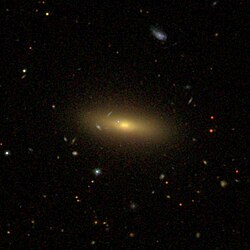| Observation data Epoch J2000.0 Equinox J2000.0 | |
|---|---|
| Constellation | Cetus [1] |
| Right ascension | 00h 56m 34.33s [2] |
| Declination | −01° 47′ 03.6″ [2] |
| Apparent magnitude (V) | 15.7 [3] |
| Astrometry | |
| Proper motion (μ) | RA: −5.284 [2] mas/yr Dec.: −15.102 [2] mas/yr |
| Parallax (π) | 0.4388±0.0530 mas [2] |
| Distance | approx. 7,400 ly (approx. 2,300 pc) |
| Details | |
| Radius | 1.56 [2] R☉ |
| Luminosity | 2.472 [2] L☉ |
| Temperature | 5,789 [2] K |
| Other designations | |
| PGC 3354 [4] | |
| Database references | |
| SIMBAD | data |
NGC 308 is a star located in the constellation Cetus. It is only 55" away from NGC 307. It was recorded on December 31, 1866, by Robert Ball. [5]
